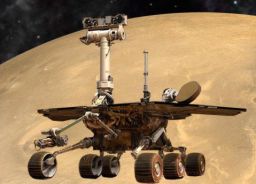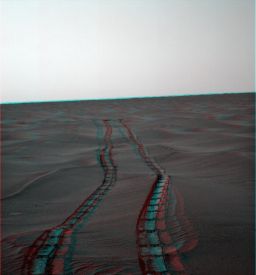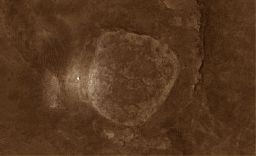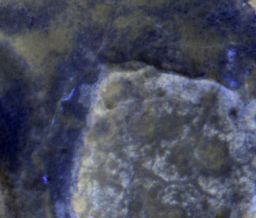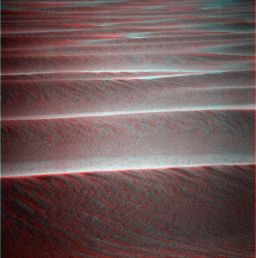A.J.S. Rayl • Apr 30, 2010
Mars Exploration Rovers Update: Spirit Snoozes Past Viking, Opportunity Snaps Endeavour on Horizon
The Mars Exploration Rovers' fourth Martian winter is proving to be the harshest one yet and Spirit and Opportunity are getting colder than ever before. With temperatures on the Red Planet dropping in April and the Martian winter solstice still two weeks away, the season has turned into a shivering nail-biter.
Spirit is ostensibly in hibernation, snoozing through the winter. In fact, yesterday the rover slept through its latest, greatest achievement, surpassing Viking Lander 1's record of 6 years and 116 days to become the longest-lived robot on Mars – provided of course that the rover is actually 'sleeping.'
In just three weeks, Opportunity will also surpass the decades-old Viking record and rove into the history books. But for this rover, this month was all about Endeavour and the breathtaking Pancam pictures it sent home. Those raw images, which the rover took with its panoramic camera, have been processed by the Pancam team at Cornell, as well as MER fans and artists around the world, into some of the mission's most glorious postcards, offering us in 'living Martian color' a spectacular view of the hills that rise up from the gigantic crater's rim. Late today, NASA/JPL released the version produced by Jim Bell and the Pancam team, which is posted below, along with several others.
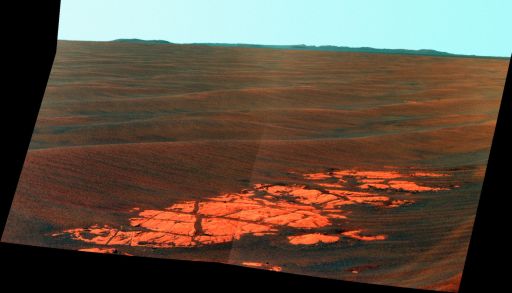 Endeavour Crater on the horizon
Endeavour Crater on the horizonThis false color rendering of the images Opportunity sent home just two days ago clearly show the hills rising from the rim of Endeavour Crater on the horizon. This crater is 21 kilometers (13 miles) in diameter, about 25 times wider than Victoria, the last major crater this rover visited. This image shows an outcrop of rocks at the foot of the rover and beyond these rocks rippled dunes, which are about 20 centimeters (8 inches) tall. The west rim of Endeavour, about 13 kilometers (8 miles) away, appears on the left on the horizon. The rim of smaller, more-distant Iazu crater, which is 7 kilometers (4 miles) in diameter and about 35 kilometers (22 miles) away, is on the far right.Credit: NASA / JPL-Caltech / Cornell University / produced by the Pancam team
At Gusev Crater, Spirit is hunkered down, parked on the west side of Home Plate in Troy, trying to stay warm. The MER engineers continued this month to believe that the rover did experience a low-power fault last month and turned off all systems and sub-systems, including communication, as it is programmed to do. Given the last recorded power levels on the rover and the falling temperatures on Mars, there is no reason right now to believe the rover didn't trip the fault. “We were all pretty surprised that the rover kept talking to us for as long as it did,” said Principal Investigator Steve Squyres, of Cornell University.
Since Spirit has not phoned home since March 22, its 2210th Martian day, the sound of silence was expected and will probably continue for the next several months; therefore, though some team members are confident that the rover did this month succeed in achieving the most significant historical milestone of the mission, it will be some months before the MER team will be able to celebrate in good conscience.
The Viking Lander 1, to recap for younger readers, was the first spacecraft to successfully land on Mars and perform its mission. It touched down in the western part of Chryse Planitia on July 20, 1976 and continued to operate until November 11, 1982. It only stopped then because a faulty command sent by ground control resulted in loss of contact. The command was intended to uplink new battery charging software to improve the lander's deteriorating battery capacity, but it inadvertently overwrote data used by the antenna pointing software, and all attempts to contact the lander during the next four months, based on the presumed antenna position, were unsuccessful.
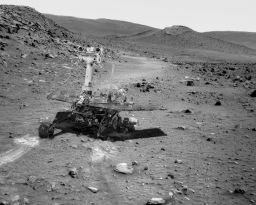 Simulation of Spirit's winter haven
Simulation of Spirit's winter havenThis artistic image, in which Astro0 has placed a two-dimensional MER into a scene created by pictures taken by the real rover, illustrates Spirit's approximate position at the location in Gusev Crater known as Troy. Although the angles are admittedly a little off and the disturbed soil isn't quite right, it offers the layperson a glimpse of the rover's present location on Mars.
Credit: NASA / JPL-Caltech / ©Astro0 2009
As huge an accomplishment as this is for two rovers dispatched on a three-month tour, for Deputy Principal Investigator Ray Arvidson, of Washington University St. Louis, the MERs capture of the Viking record will be bittersweet. As the Viking Lander imaging team leader from 1977 to 1982, Arvidson was "very disappointed" in November 1982 when contact with the spacecraft was lost. Learning it was the result of human error was like salt in a deep wound. "That was a bummer," he admitted in an interview yesterday. For now, he's doing a good job of holding his emotions close.
Not being able to talk with Spirit, however, is something to which the team has had to adjust. Neither rover has ever gone into hibernation mode before, so this is more new territory for the mission, and anything goes on Mars. "It is a strange thing," said MER Project Manager John Callas, of the Jet Propulsion Laboratory (JPL) where the rovers were designed and built and are being managed. "It's hard to know exactly how people are reacting. But we are keeping busy."
Team members are optimistic that Spirit will wake up, though that optimism is tempered, and no one is defining this Martian winter as the best of times. "It's certainly not a good time," offered Scott Maxwell the Mars Exploration Rover driver team lead. "We'd rather be hearing from Spirit than not be hearing from Spirit. But she's a tough girl. She's a fighter and people are hopeful."
The dark side of possibility is that Spirit won't wake-up, even though the MERs are wired to shut down and hibernate when the going gets cold. "These rovers are so far out of warranty they're hard to predict," Arvidson cautioned. "You're old great, great granddad can also be trained, but it's not clear he's going to wake up after a sleep overnight." True as that is, Spirit has something else going for it, noted Maxwell. "The rovers were designed to age gracefully, or in other words degrade slowly, one component at a time, not to suffer a catastrophic failure."
Like everything in life, waiting is the hardest part. The team expects that Spirit will sleep for five to six months, but winter could give way to spring more quickly than the predictions predict. And, there's always a chance, however remote, that a gust of Martian wind could clear the rover's solar arrays and Spirit could wake up and phone home, said Maxwell. "If she's got something to say, we sure want to hear it."
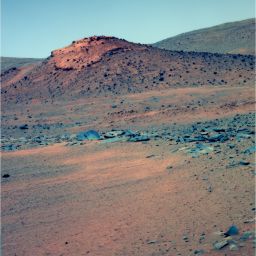 Spirit's elusive destination
Spirit's elusive destinationSpirit snapped this picture of von Braun on its Sol 2114 (Dec. 13, 2009) with its Pancam. The rover and its team had hoped to have cruised up to this geologic formation long ago, but 2009 proved to be a year of challenged mobility. Spirit remains embedded in the sands of Ulysses at Troy, where it has been since last April with this view of its elusive next-big-destination. Von Braun may be what's left of an old volcano.
Credit: NASA / JPL-Caltech / Cornell University
A team of engineers at JPL began tuning in late in March and has been listening everyday for a signal from Spirit that would come over the rover's X-band straight to the Deep Space Network (DSN) on Earth. And, several times a week they tune into the UHF radio onboard the Mars Odyssey to see if the rover has transmitted a message via the orbiter.
The MER scientists, meanwhile, continue to meet to "tag up" once a week, said Arvidson, who has passed his Spirit chair to Ed Guinness, also of the University of Washington St. Louis, while he takes over as the Science Operations Working Group (SOWG) chair for Opportunity. Arvidson is filling in for Squyres, who is overseeing NASA's Decadal Survey. "My emotions have shifted now onto Opportunity," Arvidson reported.
Actually, the operations team members, scientists and engineers alike, are almost all focused now on Opportunity at Meridiani Planum. "We've all moved over operationally to Opportunity," confirmed Arvidson, who is also serving as director of the day-to-day rover business of naming conventions, making decisions about stopping to conduct soil or rock surveys, etcetera. Since the long-term team members have switched from rover to rover throughout the years, the process has been seamless. "We've been doing this so long that the system kind of runs itself very well," Arvidson said. "But it still needs an 'adult supervisor,'" Squyres, he added, is always near. "We communicate basically telepathically when we need to."
Throughout the last six-plus years, Spirit has again and again demonstrated the mettle that made the rovers legends in their own time, so while the optimism may be tempered for every good reason, most people working on or following the mission do seem to believe deep down that Spirit will be back. "Spirit is such an old vehicle and it's never been put into this circumstance before, but I am hoping that the rover will wake up in September or October, and then I'll move back to Spirit and get it out of the sand," Arvidson finally said.
"We are keeping busy with Opportunity and that helps," summed up Maxwell. "But I do miss Spirit. And look forward to hearing from her again. And I look forward to driving her again and I look forward to getting her back on the road."
Over at Meridiani Planum, Opportunity's "eyes" are on the prize, Endeavour and the rover pressed on toward the big crater in April. "But she's empathizing with Spirit and is experiencing diminished energy," said Callas. "That is reducing energy levels and she's driving less and less."
 Endeavour as a screensaver
Endeavour as a screensaverHere is another picture of the not-so-distant Endeavour Crater and the hills that mark its rim -- this one was put together from raw Pancam images taken by Opportunity this month by Damien Bouic, aka Ant103 at UnmannedSpaceflight.com, and "one of the acest ace Mars rover image makers," as Stuart Atkinson describes him. "This view reminds me of Opportunity's early sols, when she had a view toward Endurance Crater, with the not-so-far cliffs," says Bouic. "And it reminds me of the first visual contact with Victoria Crater. I hope that we will reach the rim of Endeavour, exactly like Victoria, exactly like Endurance. If there's anything to be said, it's that this little rover has taught me something after all, nothing is impossible."
Credit: NASA / JPL-Caltech / Cornell University / rendered by Damien Bouic
Although Opportunity is not as cold as Spirit is presumed to be, and is closer to the equator than her twin, it is experiencing its coldest Martian winter yet. Opportunity's rover electronics module (REM) – which houses its computer or "brain," among other sensitive components – has dipped to the lowest levels they've ever been, "down around -37 Celsius," reported Callas, and the temperature outside is much colder. Protective heaters will automatically switch on once the levels inside the REM hit -40 Celsius (-40 Fahrenheit), but the team wants to avoid that for the simple reason that those heaters will consume a lot of power they'd rather have the rover use for driving. As a result, the engineers are commanding the rover to stay awake longer to keep her REM warm, a strategy they have used during past winters on Spirit.
Opportunity is now roving for only about 30 minutes, which enables it to cover only 30-to-50 meters on a drive sol. And, the rover is also taking sols or Martian days off to re-charge its batteries. Considering the record cold, the slowdown is hardly a surprise. "It's actually surprising that we can continue to drive the rover even in winter," Callas said. "The vehicle was never designed to even survive winter."
The rover may be driving less often now, but Opportunity certainly isn't boring anyone. The panoramic camera (Pancam) picture the rover took this month of the hills of Endeavour is compelling to say the least. "You can actually see structure in the rim," noted Arvidson. Perhaps even more importantly, the crater in all the versions the image makers have created, looks for all to be, at long last, within the rover's reach.
 Endeavour hills in 3-D
Endeavour hills in 3-DThis version of the Endeavour Hills picture was rendered in 3-D by Stuart Atkinson. "But to be honest," he says, "we're still so far away from the hills that there's not that much of a 3-D effect." We like it anyway.If you would like to read his latest MER poem, Endeavour Calls, go to: http://astropoetry.wordpress.com/2008/12/07/endeavour-calls-2/
Credit: NASA / JPL-Caltech / Cornell / rendered in 3-D by Stuart Atkinson
Although Spirit and Opportunity have returned more than 260,000 images so far, this portrait of the rim of Endeavour is being viewed by many people as one of the defining moments of the mission and is eliciting many an emotion.
"For my part, while the view out the windshield is beautiful and dramatic and evocative and a million other adjectives, the emotion that comes most immediately to mind is *frustration!*" said Pancam lead scientist Jim Bell, president of The Planetary Society. "I mean, it's going to take more than a year – maybe two years – to get to those beautiful, clay-bearing hills. It makes Spirit's agonizing three-month trek across the plains to the Columbia Hills back in winter 2004 seem like a short jog to the corner store!"
Others are metaphorically intoxicated, even romanticized perhaps, by the view. "One day astronauts will stand at the very place where Opportunity is now," mused Stuart Atkinson, a MER aficionado and poet hailing from the United Kingdom who has been giving outreach talks on the rovers in every "drafty" church basement he can find since the mission began. "Those astronauts will be followed by colonists, and settlers, historians and tourists, then school parties and they'll all devour the view, but we – you and I – are seeing this view for the first time in all of human history. This moment will never be repeated and this picture represents a unique flashbulb event in mankind's timeline. And it's ours. I can honestly imagine Ansell Adams standing beside Opportunity right now, tipping back the brim of his hat, and beaming like a kid at Christmas, imagining the wonderful views we'll all enjoy in the future.”
If the images in this Update knock your socks off, stay tuned. The view is only going to get better. "We're going up to CTX [the Context Camera onboard the Mars Reconnaissance Orbiter] and CRISM [the Compact Reconnaissance Imaging Spectrometer for Mars onboard ESA's Mars Express] to see if we can do a simulated view," Arvidson announced.
For Spirit and Opportunity time is, gratefully, marching on. Just two weeks from now, on May 13 – Sol 2261 for Spirit on Sol 2240 for Opportunity – winter solstice in the southern hemisphere of Mars will come and go. From that point, the very depths of their fourth Martian winter, the rovers will 'trudge,' however slowly, into the balmy clime of spring.
In other MER news, many of the mission scientists are finishing papers for what will be a special issue of Journal of Geophysical Research Planets slated for publication in spring of 2011. It will be the fourth MER special issue JGR Planets has published and will contain about 20 papers, said Arvidson, who just completed a 45-page overview paper on Spirit results from last winter at Home Plate. "We like to collect and keep papers periodically and JGR Planets is the place most planetary scientists publish," he noted. The mission has also garnered a special issue from Science, as well as prime print real estate in Nature, Icarus, and other journals.
More than six years into a mission that was supposed to last three months, it is remarkable that team members are still accruing the kind of informative scientific data they are. "It blows me away, totally blows me away," said Arvidson. "And it's still fun to do."
More than that, the MER mission has also been an invaluable training ground for young planetary scientists and engineers. "There hasn't been a mission since Apollo that has so inspired a generation, plus we're beginning to train and get into the community so many students, undergraduates, and graduate students who have been through the whole rover experience. So this mission has served as inspiration and training. I think it's a really good investment for the community for the future."
Spirit from Gusev Crater
As April dawned on Mars, Spirit was silent, parked, and hibernating in Troy, just on the west side of Home Plate, in the same basic location she's been in for the past year. At least that is the general consensus.
Since the rover hasn’t ‘beeped’ since its Sol 2210 (March 22, 2010), engineers have deduced that sometime in the final days of March, Spirit powered off all sub-systems except her master clock, effectively putting herself into a deep sleep, while she soaks in what sunlight is available and using as much of it as possible to recharge her two main power batteries. The rover's odometer is, of course, unchanged, stalled for now at 7,730.50 meters (4.80 miles).
When the Martian temperatures drop and power levels fall below around 135 watt-hours, the MERs are designed to trip a low-power fault and turn off their sub-systems and stop communication, as reported and detailed in the last several MER Updates. Spirit’s last reported power level was 133 watt-hours, so when it failed to phone home on March 29, engineers surmised the rover had tripped the fault and shifted into hibernation mode. Since they expected that would happen sometime in March or April, the rover was right on time.
Once her batteries recover to a sufficient state of charge, Spirit should wake up and try to communicate. When that does happen, the rover will automatically trip an up-loss timer fault that will allow her to communicate over ultra-high frequency (UHF) radio, as well as her direct-to-Earth X-band. That will allow her to phone home via two paths: X-band directly to the Deep Space Network (DSN) or through UHF via Mars Odyssey.
Since neither rover has ever before gone into hibernation, the engineers have no idea how long it will take Spirit to recharge, so they have been listening for an X-band signal from the rover every day, and a UHF 'beep' via Odyssey during selected relay passes. “We have a team that meets each week to plan for Spirit and we assemble what are called radiation sheets that the team uses to configure the DSN for the rover," Callas said. "So there is still an active operation and I think that's helpful for the team. We are listening every day, through both X-band and UHF, and if she wakes up to talk to us, we'll be listening."
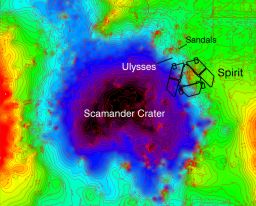 Topographic map of Spirit's location at Troy
Topographic map of Spirit's location at TroyThis topographic map of Spirit's location at Troy represents low elevations in black, purple, and blue and high elevations in red. It was developed based upon Spirit's camera images of the location, taken before it got mired at Troy. The topographic model has had a regional slope removed, which reveals that Spirit's left wheels are sitting inside a subtle depression that the team has named Scamander crater. The right-side wheels are outside the depression.Credit: NASA / JPL-Caltech / Ohio State University
Spirit is programmed to try and communicate using its X-band or UHF during specific times during the Martian sol. There is a special fault window on the rover, Callas said, that the engineers have termed generic sol time or GST. "It's a fixed Martian time of day at which the rover would attempt to communicate and it's about the middle of the day when she would have the maximum amount of solar energy. If the rover wakes up, she will also observe any scheduled UHF passes, so if for whatever reason she cannot talk to us via X-band she can talk to us via UHF and Odyssey. But it's not every Odyssey pass," he said. "We cherry-picked the best passes at the first of the week, which we put onboard Spirit before the rover went to sleep, as part of our preparing the rover for hibernation.”
No one can say when Spirit will wake-up and with no precedent a guess at this point is just a guess. Given that caveat, it will in all probability be at least several months before the rover even attempts to phone home. "We don't expect to hear from Spirit until September, plus or minus a month, so between August and October is when we should hear from her again," suggested Maxwell.
Given the brutal cold though, chances are the rover’s set of survival heaters have already automatically turned on, as Callas mentioned in last month’s MER Update. The rover engineers cannot turn-off those heaters, unless Spirit is awake, so that means the heaters are now likely competing with the batteries for the available solar energy. The power ‘war’ likely will continue for a while. “The batteries will charge to a point and then they will run into competition with this set of heaters and from that point, the charging-up will be much slower and that will draw the recharging out," Callas said.
So why are they already listening?
Because this team has learned to 'never say never' with these rovers, and it is possible Spirit could recharge enough to attempt to communicate. Even an attempt or a short 'beep' would give the team basic information, as in she's still alive and trying. Not to mention the fact that spring follows winter and no one really know how long winter will drag on or how soon spring will 'bloom.'
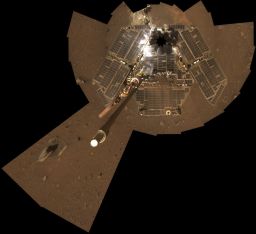 When Spirit dust was 'blown away'
When Spirit dust was 'blown away'From Sols 1976-1978 (July 24-27, 2009) Spirit tipped her panoramic cameras down to acquire a self portrait. The solar arrays are shown here cleaner than they had been in years, the result of a lucky gust of wind. "The vertical projection used here produces the best view of the rover deck, though it distorts the ground and antennas somewhat," notes Pancam Instrument Lead Jim Bell. "The eight-pointed star shape near the front of the rover (top of the image) marks the location of the camera mast, which is out of view of the Pancam atop the mast."
Credit: NASA / JPL-Caltech / Cornell University
Last Martian spring, Spirit experienced a walloping dust-clearing event that left her solar arrays shining and the rover brimming with energy. "Spirit is in a spot where she was, for a little while, as clean as she had been when she landed and was generating as much energy out of her solar arrays as she had since landing," Maxwell pointed out. "It's always possible that she could get a gust of wind that would clean off her solar arrays and come right back to us. That's very unlikely this time of year. We don't expect that. But we might as well listen."
So, while it is more likely that Spirit will be silently settled in for a while, trying to keep herself as warm as she can, all things are possible.
Yesterday, Spirit surpassed Viking Lander 1 as the longest surface mission on Mars. Who knows - being the drama queen she can be - maybe she'll wring as much drama out of this winter as possible, keeping her crew guessing until she’s good and ready to claim yet another sol in the spotlight.
The team, meanwhile, is carrying on for now without Spirit, each in his or her own way. While a few engineers are on listening watch, most have turned their focus and time to Opportunity and the scientists have turned their attentions to their data; some are further analyzing this year's findings, others are writing up the rovers’ discoveries from last year, focusing on the findings made during last year’s work on and around Home Plate.
“We were able to use Mini-TES from north side of Home to identify a group of nodular rocks that we drove to right away,” reminded Arvidson. “Those are high-silica materials in the valley to the north of Home Plate. But the new, exciting discoveries came with the transit to Troy, where we carved up all that bright material, John Wesley Powell off to the northwest corner of Home Plate, then the sulfur-rich material and the sulfate materials at Troy, particularly those the rover churned up in Ulysses, and the grinding into Cyclops' Eye and Polyphemus Eye," he said.
It's not just that Spirit found a mix of the salt and hydrothermal sulfate materials, Arvidson said. “The punchline is this: We only find the sulfate matrials when we uncover them or see them when the wheels pick them up. They're never exposed at the surface. They're dominated by ferric sulfates and are incredibly soluble. So something has been moving the soluble materials down, probably melt from snow and frost, continuing over geologic time, millions of years. We think then that little bits of water have been dissolving those ferric sulfates and moving them down in the section,” he explained.
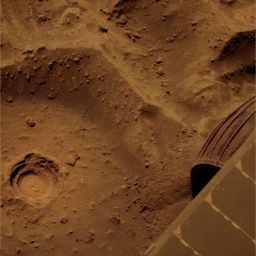 A good omen?
A good omen?This image, which Spirit took with its Pancam earlier this year, features a discreet sign of luck that just may be a good omen of things to come for this devoted and determined rover. Enlarge the image, then look inside the circular depression. As Stuart Atkinson, who discovered this, puts it: "That has to be a lucky horseshoe in that hole." Actually the rover created the circular depression with its rock abrasion tool (RAT); nevertheless, the horseshoe certainly wasn't planned. It would seem to indicate this rover is ready to rove again, but the fact that the horseshoe is positioned sideways will keep us guessing until spring.Credit: NASA / JPL-Caltech / Cornell / rendered by Stuart Atkinson
“But it's a dynamic landscape, where that section keeps being eroded away, so finding ferric sulfates not at the surface, but a centimeter beneath the surface means they can't be very old,” Arvidson continued. “Because this landscape has been stripped by wind over billions of years, it's an ongoing process, we think, a pedigenic or soil process where the very soluble ferric sulfates are moved by a little bit of water down into the section. What we did at Troy is totally rip through that stuff, at Ulysses – Sackrider, Penina – that's the bulk of the source material that was exposed. And you'd never see it from orbit, because it's just not stable at the surface."
At JPL, Callas has been organizing various "team-building" activities for the Spirit-less engineers. Last week, for example, they gathered to watch a PBS documentary about Apollo 13. “There are a lot of parallels there,” said Callas.
An explosion in one of the oxygen tanks in the two-part command-service module crippled the Apollo 13 spacecraft during flight rendering the service module nonfunctional. Commander Jim Lovell, Command Module Pilot John Swigert and Lunar Module Pilot, Fred W. Haise – were forced to orbit the Moon, using the lunar module, Aquarius, as a lifeboat, then return to the command module for the miraculous trip home to Earth.
“When Apollo 13 had problems, they were running out of power and things were getting very cold. In a different way, those are the two things that are impacting Spirit," said Callas. "The Apollo 13 crew also wondered if they could get things powered back up again after being so cold for so long, and we're looking for Spirit to do the same thing."
No matter how busy they keep themselves, no matter how much time they devote to Opportunity, Spirit is only ever briefly out of mind. The listening team informs the crew daily by email of what so far has only been silence from Spirit – or, Maxwell informed, of the "noise" produced by the Mars Reconnaissance Orbiter.
“Opportunity is swapped in now," Avidson said stoically. "You're talking to a Swede, right?” he added, chuckling. Turning serious, he asked, then answered the obvious question: "Do I think Spirit will wake up? God only knows. I'm prepared for either case. "
"Spirit is not a brand new vehicle and it is possible that we've heard the last we're going to hear from her," Maxwell agreed.
Then again, no one on this team seems ready to believe that, if only because these rovers have kicked the bar so high, have always "outperformed," as Squyres puts it, that it’s almost impossible to imagine Spirit won’t wake up. People everywhere – on the team and around the world – are keeping hope alive.
"She's been through a lot before and I believe, and I think the majority of the team believes, that we are going to hear from her again," said Maxwell. "It's just going to be a rough few months until we do,” he said, pausing. “I believe in my heart of hearts that Spirit will phone home in a few months, although my gut tells me that we will hear from her a little later rather than a little sooner. That would be consistent with her behavior over her lifetime," he smiles. "But my gut also tells me we will not only hear from her, but that we will get her back on the road in the future."
Back on the road means out of the sandy pit that has held Spirit captive for a year now. “I don't want to give anybody the impression that that is the official NASA position on the subject, but Spirit achieved 34 centimeters (1.1 foot) of progress before winter set in,” Maxell reminded, “And personally, I think she's going to go right on back out of there."
Opportunity from Meridiani Planum
Opportunity roved into April after wrapping up March with a series of drive-by photo shootings of twin craters San Antonio West and San Antonio East. On Sol 2199 (April 1, 2010), the rover left the twin craters area, taking off on a 50-meter (164-foot) drive to resume her push toward Endeavour Crater. The following sol, she stopped to rest and recharge her batteries.
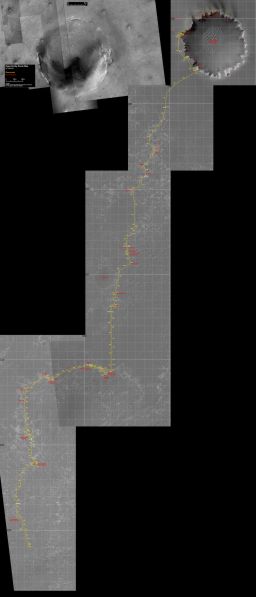 Opportunity route map
Opportunity route mapThis route map, which was put together by MER aficianado Eduardo Tesheiner, a senior member of UnmannedSpaceflight.com, is comprised of images taken by the HiRISE camera and CTX cameras onboard the Mars Reconnaissance Orbiter (MRO) and shows Opportunity's route from Victoria Crater through its travels this month.Credit: NASA / JPL-Caltech / Cornell / UA / MSSS / Eduardo Tesheiner
Despite suffering the coldest winter temperatures she’s ever experienced, Opportunity plowed ever onward throughout the month, sporting power levels “north of the low 200s,” as John Callas put it, under slightly hazy skies. As she headed into the depths of this brutal Martian season and toward winter solstice, May 13th, Opportunity also roved into a typical winter schedule of driving and then stopping to rest and re-charge.
"Although the power situation for Opportunity is nowhere near as critical as it is for Spirit, the pace has slowed down, and the rover has had to stop between drives to recharge batteries because of the diminishing sunlight,” Callas confirmed.
During that first rove of the month, Opportunity, it turned out, drove right in between two ripples, winding up in a kind of bowl. To get out, she had to pull off a couple of difficult maneuvers, beginning on Sol 2202 (April 4, 2010). The rover followed commands and pushed harder on the right side to make the required sharp turn, but as soon as she made the initial arc the current draw in the motors on the right side increased and conservatively-set current limits stopped the drive.
The current limits serve as a way for controllers on the ground to assess the driving conditions before proceeding and to protect the often-rambunctious rover. "We want to avoid any kind of embedding event like what happened to Opportunity at Purgatory Dune or what we saw at Troy for Spirit, so we have set very conservative limits on the wheels," said Callas. The rover in fact is constantly monitoring the current limit threshold to help insure it won’t get stuck.”
That noted, the occasional, slight embeddings in the sandy terrain of Meridiani Planum is a reality for Opportunity and is just something that happens from time to time, Maxwell pointed out. "This event was just in line with that,” he said. “We'll probably see this happen again off and on as we continue on to Endeavour, and when it does we'll pop her out and keep on going."
After checking everything out and determining the rover was good to go, the MER team commanded Opportunity to drive again on Sol 2204 (April 6, 2010). The rover began again with a short, sharp arc, but shortly after straightening out the wheels, wheel slip exceeding the limit of 40% stopped the drive. Sharp turns, of course, require the rover's wheels to impart more thrust, but when that thrust exceeds the shear strength of the terrain, slip occurs. Since you can never be too cautious with an aging rover on Mars, the ground controllers took the time to assess conditions and found no problems. They cleared the rover to move on she re-charged.
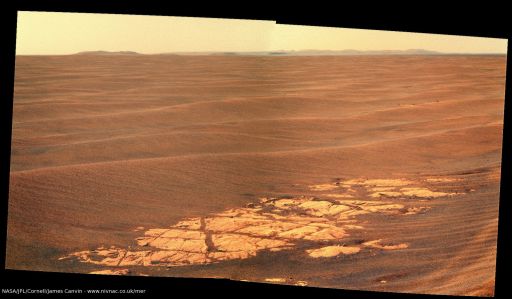 Endeavour getting "real"
Endeavour getting "real"James Canvin, MER aficionado and a senior member of UnmannedSpaceflight.com, produced this image from the raw Pancam images Opportunity sent home this month. "Now that the peaks of Endeavour are starting to show some detail, it is starting, for me anyway, to look like a real place that Opportunity my actually reach one day," he says. "Before it seemed too far and too absract to really believe. Exciting times!" For more of Canvin's work, go to: http://www.nivnac.co.uk/mer/
Credit: NASA / JPL-Caltech / Cornell University / rendered by James Canvin
Opportunity began the second week of the month with another drive on Sol 2206 (April 8, 2010). Since she was already aligned with the direction of the drive, the rover didn’t need to execute any sharp turns. However, just to be sure there were no other terrain issues though, the engineers did command her to take the time to conduct a couple of slip checks. When those checks came back 'clean,' the rover literally took off, logging some 50 meters (164 feet), picking up the pace a bit once again as she pressed on toward Endeavour.
Since Opportunity must clear a region of large ripples, she continued heading south and on 2208 (April 10, 2010) the rover put another 50 meters (164 feet) straight south behind her. Three sols later, on Sol 2211 (April 13, 2010), however, she purposefully diverted to the east, driving about 30 meters (98 feet), and then deliberately crossed a series of ripples to collect terrain data that will be used to calibrate simulation software.
Sometimes it’s easy for some people to forget, but the rovers do collect a considerable amount of engineering data on every drive in addition to the textbook-changing science they were sent to get, and sometimes the rovers go out of their way, as Opportunity did this month, to get new engineering data. This newly calibrated simulation software that will evolve from her efforts will help the team and the rover design future drives.
 Endeavour or is it Oz?
Endeavour or is it Oz?Stuart Atkinson, MER poet and member of UnmannedSpaceflight.com, offers another version of the Endeavour hills on the horizon, compiled from the raw Pancam images that Opportunity sent home this month. He says he put them together by "basically messing about in Photoshop Elements and PaintShop Pro." The objective? "Simply having fun with these pictures!" For more of Atkinson's artistic renderings, in pictures and words, go to: http://roadtoendeavour.wordpress.com/Credit: NASA / JPL-Caltech / Cornell University / rendered by Stuart Atkinson
As April progressed, Opportunity seemed to take on some of Spirit's numbing chill. "Opportunity is getting colder,” said Callas. “The rover electronics module or REM is now colder than it’s ever been, reaching as low as -37 Celsius and is getting close to -40 degrees Celsius.”
That -40 degrees Celsius (-40 degrees Fahrenheit) is key, as those who have been following this mission are well aware. When the REM, which houses many of the rover’s most sensitive components including the rover’s computer or “brain,” hits that -40 C temperature, the team knows that protective, thermostatic or survival heaters will automatically turn on and consume a lot of the little energy the rover has.
Although Opportunity is not anywhere near as cold as Spirit -- whose REM, according to projections, is expected to experience temperatures as low as -55 C (-67 F) -- the engineers are modifying her schedule. “We’re making Opportunity stay awake longer so the REM stays warm enough,” Callas said. “We don't want those heaters to come on, because they will take up energy we want the rover to use for driving.”
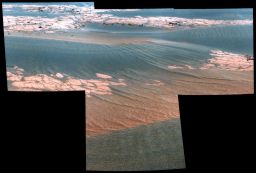 Rippled bands
Rippled bandsOpportunity acquired the images for this mosaic earlier this year, on Sol 2127 (Jan. 17, 2010). The view gives an idea of the terrain that the rover must traverse in order to get to Endeavour Crater. This picture shows patches of bedrock exposed through the Martian soil, which provides scientists information on Mars' past by showing how rock was formed long ago. Subtle horizontal bands in the overlying dunes can be seen particularly well in the false color stretch.
Credit: NASA / JPL-Caltech / Cornell University
Having to balance recharge efforts against the need to stay warm does complicate things for Opportunity. If the rover doesn't expend a minimum amount of energy into the electronics during a given sol, she risks the heaters automatically turning on. At this point however, this balancing act primarily impacts the rover's ability to drive, not survival. Simply put, Opportunity, which is closer to the Martian equator than her twin, can park herself at anytime on a sunny northerly slope to take in more sunlight and survive.
But Opportunity's prime directive is “drive, drive, drive,” as Steve Squyres has so often said. “At the same time, we want to get to Endeavour with a healthy rover. The safety of the rover always comes first," Squyres noted. And the team is taking good care of their go-getter.
Opportunity managed a few drives during the middle of the month that were upwards of 60 meters (196.8 feet), though some drives were as little as 30 meters (98.4 feet). On Sol 2213 (April 15, 2010), for example, she drove about 66 meters (217 feet), but after recharging on Sol 2214 (April 16, 2010), she only put about 36 meters (118 feet) behind her on Sol 2215 (April 17, 2010). Resting does seem to help and after two sols of recharging, the rover stepped it up, driving nearly 66 meters (217 feet) on Sol 2218 (April 20, 2010), to push her odometer to 20,553.25 meters (20.55 kilometers or 12.77 miles).
From time to time, Opportunity has been working with its new AEGIS software, as detailed in last month’s MER Update, and is “learning how to use it,” said Callas. “We ran AEGIS twice this month,” elaborated Tara Estlin a rover driver, senior member of the Lab’s Artificial Intelligence Group, and leader of development for this new software. “One image was just dunes, no real targets. The second time we picked out pieces of outcrop, which was good, but nothing was named.”
During this harshest of Martian winters, so much right now depends on the photon fuel from the Sun. As the third week of the month came to a close, Opportunity was producing a pretty solid 247 watt-hours of power. With a dust factor of 0.499, the rover was taking in and making use of almost half the sunlight beaming down on her arrays. The skies remained moderately hazy pretty much throughout the month -- the rover recorded an atmospheric opacity (tau) of 0.348 -- as expected this time of year.
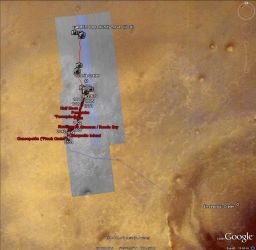 Opportunity's path to Endeavour
Opportunity's path to EndeavourThis Google Mars image features add-ons, including an additional background layer based on HiRISE image(s) covering the area outside the map provided by Google Earth, by S.F.J.Cody / route map layer, including labeled ground features, starting at Victoria Crater by Eduardo Tesheiner; planned route layer starting at Concepción, based on a paper by Tim Parker posted at Unmanned Spaceflight.com, also by Tesheiner. Credit: Credit: Google / basemap by ESA / DLR / FU Berlin, Gerhard Neukum / NASA / JPL-Caltech / University of Arizona
Although Opportunity’s power levels continued throughout April to be consistently above 230 watt-hours, her driving time as she headed toward the end of the month and closer to the Martian winter solstice was reduced to “about 30 minutes,” said Callas. “We want to make the most of it.”
After another two-sol pit stop to recharge, Opportunity hit the road again on Sol 2220 (April 22, 2010). About 10 meters (33 feet) into the drive however, she stopped. Once again this month, a slip check failed while the rover was traversing the soft side of a sand dune. No big surprise.
The engineers’ post-drive analysis determined that this slip-check failure was of the type that is expected occasionally from driving in this terrain, as Maxwell mentioned earlier in this report. It did not indicate a fundamental change in hazard level. So they commanded the rover to take off again on Sol 2226 (April 28, 2010).
In the meantime, Opportunity sampled some soil with instruments on her instrument deployment device (IDD) or robotic arm for bedrock/soil campaign the rover has been conducting all along the route from Victoria Crater to Endeavour. With that task completed, the rover took off as planned just two days or sols ago, logging another 33 meters (108 feet). That drive brought her total for the month to 350 meters (.35 kilometer or 0.21 mile) and her odometer to 20,596.37 meters (20.60 kilometers or 12.80 miles).
As April turns to May, Opportunity is producing 245 watt-hours with an atmospheric opacity (tau) of 0.35 and a dust factor of 0.46 and is schedule to drive again this weekend.For the most part, the rover drove mostly backwards throughout April and will continue to do so in coming sols.
Although Opportunity's right-front and right-middle wheels exhibited some modestly elevated motor current levels, which the MER engineers continued to watch, the roving seemed overall to be spot on. The backward driving is obviously helping to mitigate higher-than-normal currents drawn by the motors to those wheels.
"We are still driving backwards and still babying the rover and that seems to be working and Opportunity is hanging in there," said Maxwell. "The drive currents overall seem to be in family with the other wheels or very slightly elevated, so we don't see anything that looks like a developing problem. Knock on wood, it looks like we have this under control."
The real excitement from MER this month, without doubt, comes from the pictures Opportunity took of Endeavour Crater, still 12-13 kilometers away. The raw images have been assembled into one glorious picture not only by the Pancam crew at Cornell, but by MER enthusiasts and fans, especially at UnmannedSpaceflight.com, as is shown throughout this report.
Why are these pictures of the Endeavour hills so special?
For starters, because they show the rim of Endeavour and they bring Opportunity's next big attraction clearly into view, right there on the horizon. A once 'invisible' goal is now visibly within the rover's reach. For many people, however, the picture represents far more than that.
"It calls out to a very basic need in us: to reach somewhere that allows us to see further than before, and see the new land ahead, to explore," enthused rover fan Atkinson. "It's something that's in our DNA, imprinted on us. As kids we climb trees in the park so we can look out across our town and see the buildings in the distance. As adults we walk up hills for the view, always wanting to identify places and features on the horizon – and hopefully see things there we've never seen before. When we're in aeroplanes we stare out the window, hoping to catch a glimpse of a place we've never seen before, even if it's only for a moment. And we envy the astronauts up on the International Space Station (ISS) for their views of Earth. But which images call out to us the most? The ones where we can see the curve of Earth's horizon.
 Endeavour hills close-up
Endeavour hills close-upStuart Atkinson produced this close-up of the hills along the rim of Endeavour Crater. "Don't read too much into the detail visible on those distant slopes, there's quite a bit of noise in that image," he points out. "Just enjoy the view." How can we not?Credit: NASA / JPL-Caltech / Cornell University / rendered by Stuart Atkinson
"Horizons are important to us," he continued. "They are boundaries, and destinations too. These new images of Endeavour's Hills call out to us because we can identify with them. We can easily imagine we're there beside Opportunity, maybe sitting next to her, leaning back against her like hikers rest against a large stone, or maybe standing next to her, with one gloved hand resting on her 'shoulder', drinking in the view, looking at a range of hills on the far horizon, squinting in the sunlight, trying to make out details and features upon them, facing the classic dilemma of the explorer: loving the view, but desperate to be on the move again, and getting closer to those faraway hills.”
Opportunity, as this story is being written, is moving on this weekend, roving ever onward, determined, it seems, to take all of humanity right up to those far away hills, to the biggest crater the mission will explore.
The Time is Now.
As a Planetary Defender, you’re part of our mission to decrease the risk of Earth being hit by an asteroid or comet.
Donate Today

 Explore Worlds
Explore Worlds Find Life
Find Life Defend Earth
Defend Earth


